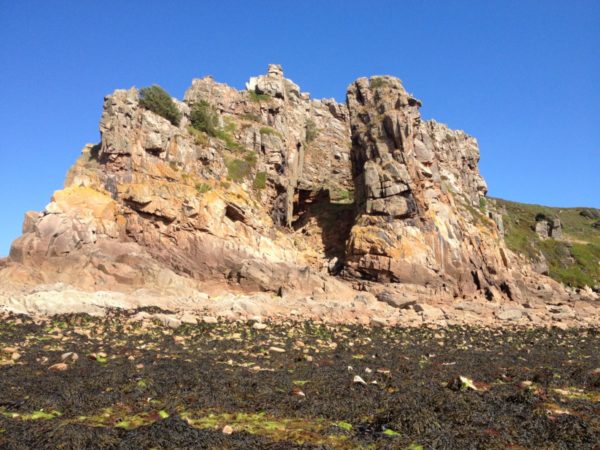La Cotte

A proud rocky headland overlooks a sandy Bay. Today, the beach is busy with people enjoying the fresh sea air: walking dogs, swimming in the sea, kayaking or coasteering. Atop the rocky headland, with tall granite cliffs that were formed millions of years ago, is a tiny white cottage that was originally built during the 18th century as a fortification to protect the Island from invasions.
Nestled in the granite cliffs are hidden treasures from a time when the landscape here was very different. This was a landscape where tundra-like plains stretched out as far as the eye can see towards the horizon, during a time where rivers ran across the Channel between England and France. Evidence from this site suggests that Neanderthals hunted mammoth and woolly rhino for around 250,000 years in the Ice Age. This place’s name, Cotte, is Jèrriais for cave, which is fitting for the site. The past climate record of this site tells us how the environment has changed over hundreds of thousands of years.
La Cotte de St Brelade (La Cotte) is a key site in European prehistory, preserving one of the best records of Neanderthal behaviour from over a quarter of a million years ago in the Ice Age past. Situated on a granite headland on Jersey’s south west coast, the collapsed cave and granite ravines of La Cotte provided a home for Neanderthal hunters-gatherers for over 200,000 years.
Since ancient stone tools were first found at the site in 1881, stunning discoveries have been made by successive generations of archaeologists. La Cotte provided early fossil evidence for Neanderthal people, exciting records of their use of fire, and heaps of bone which showed how they could work together to hunt Ice Age megafauna such as mammoth and woolly rhinoceros.
In 2010, the Ice Age Island team began to survey La Cotte de St Brelade, determining both that the site contained further Neanderthal archaeology and that it was under threat from significant coastal erosion. Since then, Jersey Heritage and the Société Jersiaise have worked with engineering teams from the Channel Islands and UK to transform the site into a place that is both safe to work in and secure from further damaging erosion. The engineering project represents a bold and innovative response to the effects of sea level rise and climate change and provides an opportunity to safeguard an internationally important scientific record. It has also opened the way for renewed large-scale archaeological research.
La Cotte de St Brelade preserves a unique record of our closest human relatives. Now, for the first time in the site’s history, it is possible to safely excavate within this massive site. In the summer of 2019 the Ice Age Island team initiated the first stage of this project with a short intense season focussed on the west ravine. From this first season researchers gained valuable information which will help shape a long-term project, bringing the west ravine under new understanding, leading to new discoveries, and protecting the archaeology.